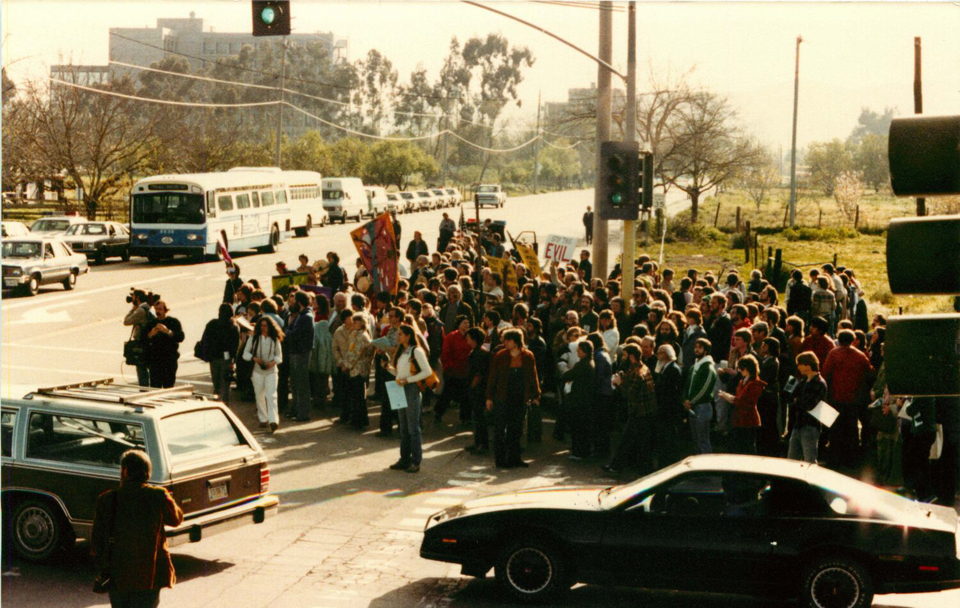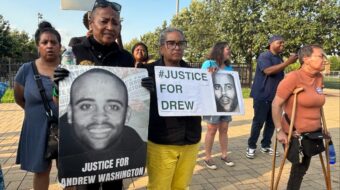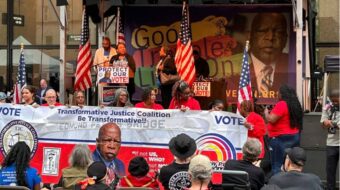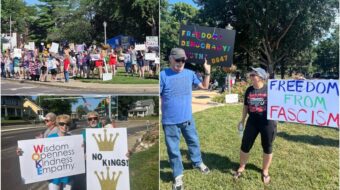
A longstanding tradition took a new form this year, as nuclear disarmament advocates gathered virtually for the annual Good Friday Vigil normally held at the entrance to the Lawrence Livermore National Laboratory in Livermore, Calif., which is at the center of the Trump administration’s drive to develop new, ever more dangerous types of nuclear weapons.
As participants marked their presence on the edges of the video screen, DePaul University professor Dr. Ken Butigan, who helped found the vigils in 1983, joined from Chicago. Butigan, a renowned advocate of nonviolent change, brought to the gathering thoughts on how the theme of this year’s vigil—“For the Healing of the Nations”—brings together today’s all-consuming global COVID-19 pandemic and the decades-long existential global crisis of nuclear weapons, and points the way toward a world built on action for the common good.
As the Pentagon’s demands for money soar, he said, COVID-19 is making clear that humanity’s survival depends on creating a global safety net, with universal health care, economic and social equity, dignity and human rights for all.
“We can join with our sisters and brothers worldwide who have faced the brunt of the crisis,” Butigan said, “to set the world once and for all in a new direction—a world building on the power and spirit of nonviolent engagement that has been unleashed in response to this disaster: compassion, courage, resilience, sacrifice and concerted action for the common good.”
Among many who offered spiritual and musical tributes were Zahra Billoo, executive director of the Council on American-Islamic Relations/San Francisco; Carl Anderson, Livermore Conversion Project; musician Daniel Zwickel; the Rev. Max Lynn, St. John’s Presbyterian Church/Berkeley; and Janet Cordes Gibson, Ecumenical Peace Institute. The gathering, planned by the Ecumenical Peace Institute/CALC and the Livermore Conversion Project, was co-sponsored by over two dozen organizations and churches.
The Trump administration’s push to escalate nuclear weapons spending in Fiscal Year 2021 was foreshadowed in the Nuclear Posture Review it issued early in 2018.
In its Spring 2020 news bulletin, Citizen’s Watch, Tri-Valley Communities Against a Radioactive Environment (Tri-Valley CAREs) highlights the administration’s request, which is 20% higher than that for 2020, and over 50% more than the annual funding level when Donald Trump took office. The proposal is now subject to Congress’s months-long budget process.
Vigil co-sponsor Tri-Valley CAREs, whose mission statement includes abolition of nuclear weapons worldwide and conversion of Livermore Laboratory to “socially beneficial, environmentally sound” research, says the request highlights three dangerous trends:
- Every weapon in the U.S. nuclear arsenal is being modified and two totally new warheads are being developed. One, W80-4, is to be launched on a new long-range standoff air-launched cruise missile and the other, 87-1, is for a new intercontinental ballistic missile. Both are being developed at Livermore Lab.
- A new infrastructure is projected to speed up weapons production, including industrial-scale production of plutonium pits and ramping up uranium operations.
- More funds are sought to develop nuclear weapons testing capabilities.
Funding requests for Livermore Lab have increased by 45% since Trump took office, and this year’s ask would raise funding to develop new and modified nuclear arms by 13%.
Tri-Valley CAREs Executive Director Marylia Kelley was scheduled to update vigil participants on the lab’s work but was unable to do so because of an internet outage.
In a conversation this week, Kelley called the administration’s request “a truly shocking increase. Here in the midst of the pandemic, the activities considered essential are the continued development of new nuclear weapons that rob our treasury and make the world less, not more, safe. That’s a tragedy in any year—it’s a particularly poignant tragedy in this year.”
For nuclear weapons to be developed, she said, two things are needed: nuclear materials and money to fund research. Since the U.S. already has large stockpiles of the nuclear ingredients, “the key factor is money. Stopping the further development of nuclear weapons requires stopping the flow of money. That’s one reason we focus on the nuclear weapons budget and on getting information out to people in different congressional districts, in a way that’s not only timely but so early it’s actionable.”
The priority the Trump administration is giving to ramping up pit production, she said, is directly linked to the development of the brand-new 87-1 warhead. Livermore Lab’s “key role” in these developments makes it necessary to focus on the lab and its role in creating a new arms race.
Though Congress is officially on recess until at least early May, Kelley said that by keeping up public pressure through posting on social media, writing letters to the editor, organizing events via teleconference, and communicating and meeting remotely with a staff of legislators who sit on crucial committees, disarmament advocates can work to keep nuclear weapons issues at the forefront of the Congressional budget process.
She suggested focusing special attention on House and Senate members serving on Armed Services committees and their staff members who are responsible for defense issues and noted that the budget for nuclear weapons actually goes through the energy and water appropriations process.
“If there’s a silver lining to this cloud,” she said, “they may have slightly less to do and be more dependent on reading their emails.”
While some scientists are always engaged in weapons-related work, Kelley said, many move into and out of weapons programs as they are needed, and other programs they work with could become the core of the laboratory’s work.
The most obvious example, she said, is a global climate change program, now a very small part of Livermore Lab’s work but viewed as one of the world’s renowned climate change programs. The computers those scientists are using are “among the best global climate scientists have in the world,” though they are significantly inferior to those being used for weapons work. “So one of my fantasies,” said Kelley, “is that the weapons folks move out and the climate scientists move in and get to use the fastest and most sophisticated computers in the world.”
The National Ignition Facility, built for the weapons designers, could be shifted from examining the temperatures and pressures involved in nuclear weapons to examining temperatures and pressures at the Earth’s core.
Meanwhile, Livermore Lab is issuing press releases about use of its computers, along with those from other institutions, to help in the search for a vaccine against COVID-19.
Among other potential benefits from transitioning to civilian research: democratization of science, openness, transparency, and accountability.
“This is the time to do it,” Kelley said. “That is both the hope and the challenge of this time!”
Like free stuff? So do we. Here at People’s World, we believe strongly in the mission of keeping the labor and democratic movements informed so they are prepared for the struggle. But we need your help. While our content is free for readers (something we are proud of) it takes money — a lot of it — to produce and cover the stories you see in our pages. Only you, our readers and supporters, can keep us going. Only you can make sure we keep the news that matters free of paywalls and advertisements. If you enjoy reading People’s World and the stories we bring you, support our work by becoming a $5 monthly sustainer today.










